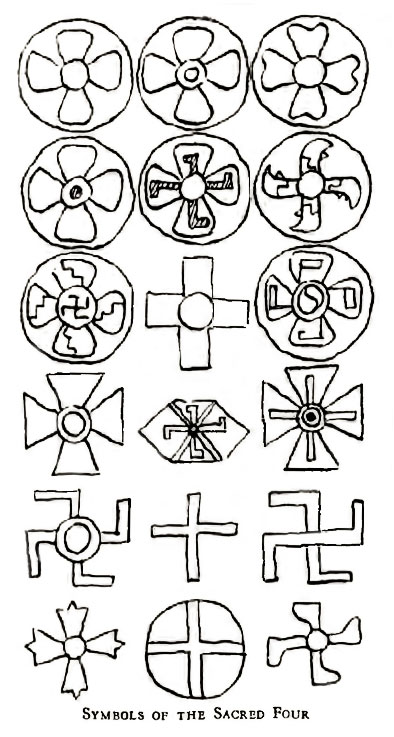Remarkable Achievements Of The Lemurians
 by Wisher S. Cerve
by Wisher S. Cerve
Aside from the unusual psychic development or spiritual unfoldment attained by the Lemurians and which gave them unusual advantages in a purely personal and individual sense, the people as a race and as a nation attained a high degree of development in the arts and sciences and in the mastership of worldly problems.
When it is said in modern writings that the ancient Egyptians attained a degree of civilization and intellectual mastership that was superior to our present day attainments, this is generally said in a relative way, for it is only relatively true. When we say that the Lemurians reached a higher degree of civilization then we have reached, it is likewise meant in a relative sense, although there are some evidences of attainment that were actually beyond the scientific achievements of modern times.
When we stop to consider, however, the natural difficulties which surrounded these ancient peoples, and keep in mind the fact that they did not have the advantages which we now have and that many of our present day achievements are based upon discoveries which they made, we can truthfully say that these ancient peoples did attain a higher degree of civilization compared to the times and conditions in which they found themselves than we of the modern world have attained.
If a man is stranded in his youth on a barren island and during his lifetime is capable of evolving methods of extracting from the earth his necessities and turning gross matter into refined instruments and with these build beautiful homes and create the things he needs for a life of ease and luxury, we can truthfully say that he, as an individual, attained a greater degree of mastership in the arts and sciences than would an individual living during the same century in a modern city with all of the advantages and necessities supplied to him.
It is true that today we have many marvelous scientific achievements that are rapidly becoming commonplace, and which our children and grandchildren will look upon as ordinary conveniences of life. Many of these were undoubtedly unknown to the ancient people of Lemuria, or Egypt, or any other old country. To say, however, that these modern achievements, which we have and which they did not have, indicate a higher degree of advancement, a higher degree of civilization and culture than was enjoyed by the ancient people, might be a serious mistake. The Lemurians, for instance, did not have our modern radio methods, but even these modern methods of communication are becoming cumbersome and every scientist and philosopher dreams of further improvements whereby this cumbersome system may be simplified.
We may find, for instance, that the methods which the Lemurians had for communicating to great distances was a higher phase of scientific achievement than our present day radio, for I have already explained to you that the Lemurians were capable of mental communication, regardless of distance, through the effort of a faculty which we have dubbed “mental telepathy.” This would indicate that whereas we have placed our faith in the forces of nature, such as electricity, and have created machinery for the transmission of this energy from one distant place to another, the Lemurians proceeded along much higher lines and developed a faculty within their own beings for the transmission of an energy more refined and higher in its vibrations than the crude electrical energy which we use. Their means for distant communications was not surrounded by cumbersome equipment and by interferences from electrical storms and by rules and regulations and finances. The ease with which they could communicate and the dependability with which the communications were transmitted and received certainly represents a higher achievement in this field than our present day radio, just as radio and telegraphy represent a higher achievement in our art of communication.
In many Oriental lands, today, tourists of the thinking class and investigators are frequently astonished at the rapidity with which a story or a message or an important fact is made known to various persons at very distant points. The art of communicating thoughts is still a mysterious art, despite all of our scientific achievement, and is really classified among the arcane mysteries awaiting further scientific development.
In many other respects, however, the Lemurians achieved great fame and mastership. In the art of building, for instance, the Lemurians constructed with plans for greater permanency than any other nation of people. They knew from long experience that their continent, as well as the rest of the world, would be rocked and shaken by earthquakes and volcanic eruptions and that periodic changes in climate would also affect everything that they built. They, therefore, made a careful study of the science of balancing and the art of calculating the principles of stress and strain. When we realize that some of their structures stood for nearly thirty thousand years without being damaged by any of the cataclysmic changes, we see at once how marvelously they had mastered this problem. When we think of how modern built buildings, designed and constructed by architects and contractors who have access to all the facts and figures of the earth’s changes, are quickly thrown down by even light earthquakes or temblors, we cannot feel such great pride in our achievements in the art of building.
As we pass by any modern electric or steam power plant and see the enormous amount of material, labor, and money invested in such elaborate equipment solely for the purpose of giving us a form of nature’s energy, and then think that the Lemurians used the natural energy without all of this equipment, we see that we have not progressed as greatly in our mastership of the earth as we think we have.
The Lemurians harnessed all of nature’s forces in a truly scientific manner and with extreme efficiency. I have spoken of how they were able to propel their boats in water by using the energy that radiated from a stone. Undoubtedly a similar device was used in the propelling of their airships through the air, for they did use airships quite frequently. Since they needed no engine, no gasoline, and no long-armed propellers, their airships were lighter and much different in design from anything that we have been able to attain at the present time. Furthermore, they were able to have lights in these airships and to use a searchlight that cast a beam to a greater distance than is cast by any of our present searchlights. Whatever the nature of this light, its energy was not produced by any revolving machinery or by gasoline or gas, but undoubtedly from some minerals small in size but which could be so harnessed or utilized that their radiations furnished the necessary energy.
We are only beginning to study the nature of radioactive or radiating minerals and we are only speculating at the present time on the possibility of harnessing our natural, universal energies. Scientists tell us that there is sufficient stored-up energy in one atom to cause a terrific explosion, if we only knew how to use this energy and apply it safely. The Lemurians, either by force of circumstances or through a greater understanding of Cosmic energies, were able to use the power in many minerals and apply this power very specifically and efficiently. One of the outstanding features of Lemurian scientific achievements was the utilizing of the energy and power that is constantly bathing this earth in the sunlight. In our present day period of scientific achievement, we are just speculating with this possibility and a few small engines have been constructed which operate with sun power. The Lemurians used this sun power very freely and very universally in all of their communities. It gave them light and heat and energy at night and gave them enormous motive power during the day for the movement of great pieces of stone and wood in their constructive operations.
In botany they were so expert that agriculture with them became like the expert work that is shown at a botanical garden. In art they were guided by their superior knowledge of fundamental Cosmic laws and by certain rules which are taught today only in the architectural schools, but which they used not only as fundamental principles for living, but in all of the sciences and activities of earthly life.
Many of their homes were carved in solid rocks on mountain sides; on the other hand, others were built of rare stone to represent in symbolical form the great temples of knowledge having spiritual or Cosmic lines and contours.
These Cosmic principles were expressed in many ways by the Lemurians but we find the fundamental law of these principles expressed by the Lemurians as “The Law of the Sacred Four.”
The drawing given herewith illustrates some of the forms in which The Law of the Sacred Four was represented either in a very definite form, like the plain cross, or in a decorative form. It will be noticed that generally a circle was drawn around the outside of the symbol of the Four since this circle represented the lines of the universe and carried the intimation that the completed universe or anything in its completed expression, having no beginning and no ending and lasting eternally, was based upon the Law of the Sacred Four. The center example at the bottom of the drawing shown herewith, containing a cross with its sides touching the circle, became known in later years among the descendants of the Lemurians as the Wheeled Cross. While it is true that this form also became typical of the wheels found on the earliest carts or wagons, the wheel was connected with this symbol because of the turning of the earth and the passage of earth through Cosmic space. In other words, it represented revolution. This Wheeled Cross later became the first symbol of the mystic Rosicrucians who were the inheritors of the earliest mystical teachings of the Lemurians through the mystery schools of India and Egypt.
 The four principles referred to by the Lemurians in their legend were the Creative principles of the universe, as well as the four fundamental laws governing the geometrical and mathematical form of everything that was created. Since the outside circle represented the universe, it was sometimes drawn in the shape of an egg, for the Lemurians considered the egg as symbolical of the birth place of all living things. The Sign of the Four, showing the cross within the egg, represented the process of germination. An ancient Lemurian legend said that in the beginning God commanded the four principles to bring forth all life and that the four principles began their work within a Cosmic egg. It may be interesting to speculate for a moment upon the many forms in which the cross has been adopted as a symbol by various races of persons in all ages of time and even as a symbol of religious and philosophical thought. This is just another instance of how a truly sacred or spiritual and philosophical principle, universally recognized today, can be traced to the high spiritual illumination of the Lemurians. The designs shown herewith are drawn from many ancient Lemurian carvings, found not only in California and South American communities established by the descendants of the Lemurians, but on many of the islands of the Pacific.
The four principles referred to by the Lemurians in their legend were the Creative principles of the universe, as well as the four fundamental laws governing the geometrical and mathematical form of everything that was created. Since the outside circle represented the universe, it was sometimes drawn in the shape of an egg, for the Lemurians considered the egg as symbolical of the birth place of all living things. The Sign of the Four, showing the cross within the egg, represented the process of germination. An ancient Lemurian legend said that in the beginning God commanded the four principles to bring forth all life and that the four principles began their work within a Cosmic egg. It may be interesting to speculate for a moment upon the many forms in which the cross has been adopted as a symbol by various races of persons in all ages of time and even as a symbol of religious and philosophical thought. This is just another instance of how a truly sacred or spiritual and philosophical principle, universally recognized today, can be traced to the high spiritual illumination of the Lemurians. The designs shown herewith are drawn from many ancient Lemurian carvings, found not only in California and South American communities established by the descendants of the Lemurians, but on many of the islands of the Pacific.
The Lemurians must have enjoyed life to the fullest extent, for they had invented and devised ways and means of producing all of the necessities and all of the luxuries required by them. Certainly, the present day races of man have not reached this point. We have entered into a cycle of artificialities, bringing forth artificial and unreal desires that can be satisfied only with artificial things. We have developed the stage and the production of theatricals as an artificial means for the study of history and human problems. Having entered into this fictitious manner of study, the stage has rapidly developed until we believe the theater plays and moving pictures are of educational value and a real necessity as a form of amusement. If we can realize for a moment that the real study of human beings around us and an analysis of things that are actually occurring in every day life are the basis of all theatrical productions and could easily supplant the artificial productions on stage or screen, we will see that the Lemurians missed nothing of the luxuries of life through not having our present day moving pictures, despite the fact that we consider any community in which there was no theater or no pictures of this kind as being antiquated and lacking an essential form of pleasure.
The same principle is true regarding many of our other modern accomplishments. The seeming necessity for money and the seeming necessity to save time are two of the artificial standards responsible for most of our modern scientific achievements. We require automobiles and other means to transport us rapidly from place to place in order to eliminate a false valuation of time. Our radio is an attempt to out-do the telegraph and telephone, as well as the post in the transmission and reception of communications, but here again it was the element of time that was given the greatest consideration. We are building great buildings and great communities, not because of the artistic arrangement but because of an artificial necessity based upon an artificial valuation of land.
If we analyze what we have today as representing our advancement in civilization, we will find that we have gained nothing that the ancients did not have and which they enjoyed to a greater extent because of its naturalness. Of the artificial things, however, or the unnecessary things brought into existence by a false realization of life itself, we will discover that most of these could be eliminated from our life if we lived properly, and their lack would not constitute a real detriment nor an obstacle in the attainment of peace and happiness.
The Lemurians, therefore, devoted themselves very greatly to the establishment of communities in distant lands and to the education and advancement of the races of man which were emerging from the early foundations laid by their own people. In one old record there was found an interesting story of how the later descendants of Lemuria visited a community in Alaska which had been founded by some of the early pilgrims from Lemuria. These late voyagers expected to find these descendants in Alaska enjoying all the advantages of life which the Lemurians had created on their own continent. They were surprised to find that these people in Alaska had retrograded and had become so distinct in color of complexion, in manner of dress, in form and habit, and even in writing and speaking, that they had difficulty in becoming convinced that they had not come upon an entirely new race of earthly people. Great missionary work was attempted to aid these descendants in modernizing their communities and reaching the same degree of development as those who had remained on the continent of Lemuria. It appears, however, that they never completely succeeded in doing this and abandoned the work because they found that the climate and general conditions had made the people lazy and indifferent in cultural development, and it is more than likely that from this period onward through history, this tribe in Alaska spread into other lands, intermarried, lost most of its racial distinctions, and became a nomadic people probably still remaining in northern zones.
The pilgrimages to other lands were highly successful and records show that the Lemurians kept in contact with their people in Mexico and South American countries, and in Egypt, Asia, and parts of Europe, throughout many centuries, and through this continued contact and comparison of ideas and principles there came to be a universal establishment and agreement in regard to certain points of agriculture, buildings, language, music, art, ritual, and other human activities which are outstanding points of racial identification today.
Excerpt from Lemuria: The Lost Continent Of The Pacific
See Part II here.
To continue reading see full pdf download here.
Posted in Lemuria, Other Topics, True History of Manwith comments disabled.





